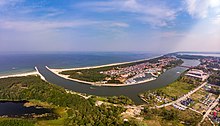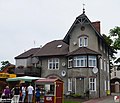Dziwnów
| Dziwnów | ||
|---|---|---|

|
|
|
| Basic data | ||
| State : | Poland | |
| Voivodeship : | West Pomerania | |
| Powiat : | Kamień Pomorski | |
| Area : | 4.90 km² | |
| Geographic location : | 54 ° 1 ′ N , 14 ° 45 ′ E | |
| Residents : | 2663 (Jun. 30, 2019) |
|
| Postal code : | 72-420 | |
| License plate : | ZKA | |
| Economy and Transport | ||
| Street : | DK 102 Międzyzdroje ↔ Kołobrzeg | |
| Next international airport : | Szczecin-Goleniów | |
| Gmina | ||
| Gminatype: | Urban and rural municipality | |
| Gmina structure: | 6 school offices | |
| Surface: | 37.91 km² | |
| Residents: | 3963 (June 30, 2019) |
|
| Population density : | 105 inhabitants / km² | |
| Community number ( GUS ): | 3207013 | |
| Administration (as of 2011) | ||
| Mayor : | Grzegorz Jóźwiak | |
| Address: | ul.Szosowa 5 72-420 Dziwnów |
|
| Website : | www.dziwnow.pl | |
Dziwnów [ ˈʥivnuf ] ( German Dievenow ) is a town as well as a port and seaside resort in the powiat Kamieński of the Polish West Pomeranian Voivodeship on the Baltic Sea with the seat of an urban and rural municipality of the same name.
Community structure
The urban and rural municipality Dziwnów (Dievenow) covers an area of 37.91 km², on which about 3000 people live. The municipality has three other districts:
- Dziwnówek ( Dievenow Forest , also known as Klein Dievenow ) is about 2 km from the center of Dziwnów.
- Łukęcin ( Lüchenthin ).
- Międzywodzie ( Heidebrink ) has extensive beaches, one of the most famous holiday destinations on the Baltic Sea in Poland.
Geographical location


The village, which is located in Hinterpommern , is located on an average 400 m wide, 6 km long headland of the Pomeranian mainland between the Dievenow estuary and the Baltic Sea. The headland extends from east to west of the island Wolin ( Wollin ) and delimits the Fritzower See (Polish: Jezorio Wrzosowo ) from the Baltic Sea. At Dziwnów the Dziwna ( Dievenow ) flows into the Baltic Sea , the right of three inlets that connect the Szczecin Lagoon with the open Baltic Sea.
history
The village was known as a German seaside resort since 1827. Until 1945, Dievenow belonged to the administrative district of Stettin in the Pomeranian province . Before 1945 the village consisted of four independent places:
1. East Dievenow
2. Berg Dievenow
3. Klein Dievenow
4. West Dievenow
With the exception of Klein Dievenow, the districts were located on the 6 km long headland between the Dievenow estuary and the Baltic Sea. Except for West Dievenow, which belonged to the Usedom-Wollin district, the districts were in the Cammin i. Pom. Farthest forward on the headland was the Ost-Dievenow lake and brine bath, which was the most important district of Dievenow at the time. Berg Dievenow was also a brine bath since 1895. The fishing village of Klein Dievenow was originally a Vorwerk of the village of Fritzow in the northern corner of the Camminer Bodden ( Fritzower See ). In 1935 the towns of Berg Dievenow and Ost Dievenow , in front of which a long beach promenade stretches, were merged to form Dievenow .
Between east and west Dievenow a ferry operated over the Dievenow in 1920 (according to MTB).
Towards the end of the Second World War , the Red Army had advanced rapidly on March 4th and 5th, 1945, coming from the south-east, towards the Stettiner Haff , Dievenow and Oder , but had to stop there for nine weeks. The fighting on the Dievenow peninsula continued until the beginning of May. During this time, the region from the island of Wollin and the Baltic Sea was under constant German artillery fire. Dievenow and other localities were badly damaged.
After the end of the war, Dievenow became part of Poland together with the whole of Western Pomerania . The German seaside resort Dievenow was given the Polish name Dziwnów .
On January 1, 2004 Dziwnów received city rights.
Development of the number of residents and guests
-
East Dievenow
- 1910: 2,700 bathers
- 1923: 1,830 bathers
-
Mount Dievenow
- 1910: 339 inhabitants, 2,700 bathers
- 1923: 450 inhabitants, 6,000 bathers
-
Klein Dievenow
- 1910: 130 inhabitants
- 1923: 200 inhabitants
Town twinning
- Sosnowiec ( Sosnowitz , Poland, Silesia)
- Werneuchen (Germany, Brandenburg)
Attractions
- Dievenow harbor
- Dievenow bascule bridge
- Cormorant colony opposite the Berg-Dievenow district
- Sandy beaches on the Baltic Sea with bars
- Some preserved bath villas on the promenade and in the core of the seaside resort districts
Partially renovated bath villa in Dziwnów (30 Mickiewicza Street)
Personalities
sons and daughters of the town
- Jürgen Lüthje (* 1941), German lawyer
People who have worked in the city
- Rudolf Hartmann (1856-?), German politician (DNVP), practiced as a spa doctor in Berg Dievenow
literature
- The district of Cammin - A Pomeranian homeland book (compiled and developed by Hasso von Flemming-Benz). Holzner, Würzburg 1970.
Web links
- Districts: Commons : Dziwnówek - collection of images, videos and audio filesCommons : Łukęcin - collection of images, videos and audio filesCommons : Międzywodzie - collection of images, videos and audio files
- Districts:
- City website
See also
Footnotes
- ↑ a b population. Size and Structure by Territorial Division. As of June 30, 2019. Główny Urząd Statystyczny (GUS) (PDF files; 0.99 MiB), accessed December 24, 2019 .
- ↑ Gunthard Stübs and Pomeranian Research Association: The community of West Dievenow in the district of Usedom-Wollin in Pomerania (2011)
- ↑ Detailed description of the current state of the Royal Prussian Duchy of Western and Western Pomerania ( Ludwig Wilhelm Brüggemann , ed.). Part II, Volume 1, Stettin 1784, pp. 35–36, No. 13 .
- ^ Michael Rademacher: German administrative history from the unification of the empire in 1871 to the reunification in 1990. Cammin district. (Online material for the dissertation, Osnabrück 2006).
- ↑ Flemming-Benz (1970), p. 532.
- ↑ Flemming-Benz (1070), p. 533.
- ↑ disposal of the Council of Ministers of 22 July 2003 Dz.U. 2003 nr 134 poz. 1248. Online
- ↑ a b c Meyer's travel books: Baltic resorts and cities on the Baltic coast . 4th ed., Bibliographisches Institut, Leipzig and Vienna 1910, pp. 130-134.
- ^ A b c Meyer's travel books: German Baltic Sea coast . Part II: Rügen and the Pomeranian coast with its hinterland . 2nd ed., Leipzig 1924, pp. 158-261.







